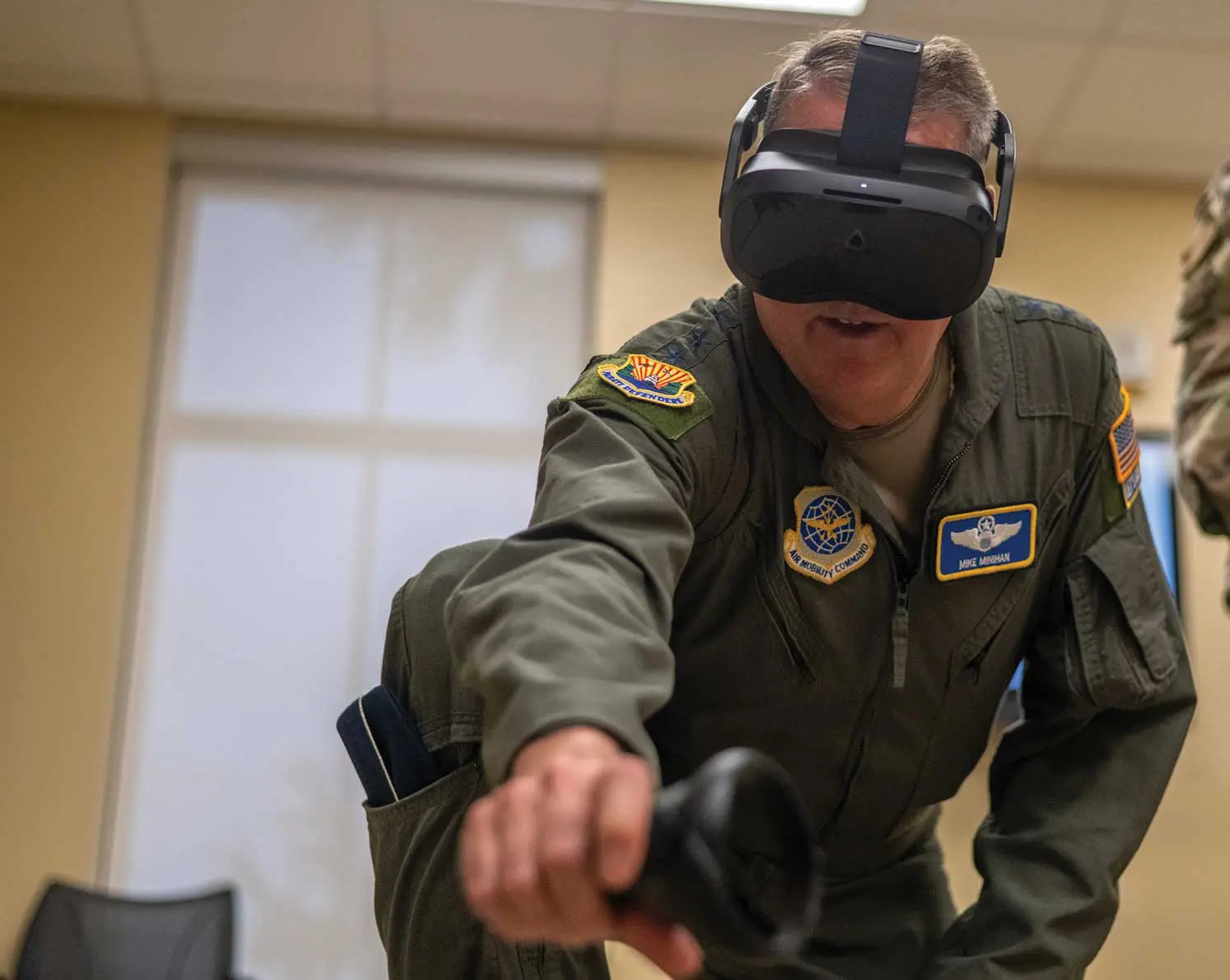Next Generation Technology: Pros and Cons of Using Upcoming Technology to Train Airmen
By MS. DARA MARLAR, STAFF WRITER
The only way to become proficient is by doing.
By completing a task multiple times, you develop the muscle memory and instinctual mechanical skills needed to complete the task without thinking. It is not always easy to complete the same task over and over again in many environments, especially military environments. This is how gaming technology and military training come together to help Airmen become proficient without the danger and cost of traditional training. The use of technology gives the Airmen an edge that is needed to compete in contested environments. With the military stepping into the metaverse, it is important to understand the pros and cons of technology usage in training.
The use of gaming technology in training, including Augmented Reality (AR) and Virtual Reality (VR), can provide significant learning advances. By simulating real-world learning environments and immersing the user in virtual situations, the technology helps increase an Airman’s retention and preparedness.
Using a learner-centric environment and allowing Airmen to progress at their own pace, gaming technology can help the Airmen learn hands-on in a shorter timeframe than traditional training. Airmen are better prepared to operate in disrupted environments if they have seen and interacted with a particular environment before, and the use of AR and VR allows this to happen.
Another benefit of using gaming technology for training is the overall reduction of cost. Although an AR or VR system outfitted for an entire team might have a high dollar amount initially, the investment reduces the cost of training in the long term. Technology can help the government save money on travel, expensive munitions, fuel, and other overhead expenses of conventional training, so the initial investment in the technology is a very cost-effective approach.
Using technology for training also reduces the risks for each Airman. They can fly, use weapons, operate vehicles, practice tactics, and confront incoming threats without the possibility of injury.
Not only can AR and VR technology keep an Airman safe during training, but that training can be applied to real-world situations in an aircraft.
Having trained using a system developed to mimic the aircraft they are using, Airmen can gain a familiarity with the controls that would otherwise not be possible, making their reaction times quicker and more seamless.
Although AR and VR technology has advanced drastically in the past 10 years, it still has some major drawbacks. One of the major threats with using technology to train Airmen is the cybersecurity risk. Anything that is online or on a server has the potential to be hacked. This risk has generated substantial resistance toward merging any kind of networked technology and military operations.
Another major disadvantage to technology in training and education is the possibility of cyber-sickness. This feeling, similar to motion sickness, can ground an Airman for hours or days. The ailment is caused by the difference in motion between what you are seeing and what you are feeling. If you are standing on solid ground and experience an earthquake in virtual reality, the vestibular system that controls balance gets confused because it “sees†that the ground is shaking but does not “feel†it.
Technology has been used for centuries by the military to train personnel. The ability to train Airmen safely while teaching them the lessons they need when in a combat environment, combined with the other advantages, means that technologies like AR and VR are going to be sticking around for the long-haul.
TIMELINE OF MILITARY USE OF GAME TECHNOLOGY FOR TRAINING PURPOSES
1948
The Army Operations Research Office at Johns Hopkins University in Maryland developed the first “computerized†war game called Air Defense Simulations. Although not computerized as we know it today, these games eliminated much of the manual work previously completed by the player, such as the movement of pieces, rolling dice, and looking up results.
1953
The same team with the Army Operations Research Office developed Carmonette, a series of games that allowed the players to focus on tactical movements.
1960s and 1970s
The first example of modern multiplayer simulation games was used by the McClintic Theatre at the Army War College, which included computerized mathematics, logical algorithms, and attractive graphics to drive the game.
1961
Spacewar! Was created by a team at Massachusetts Institute of Technology. The game ran on a DEC PDP-1 computer.
1974
Battle for Wargamers magazine began publication, and it was later merged into Military Modeling in 1978.
1980s
The end of the “computerized†board game and the introduction of computer games.
1980
The U.S. Army commissioned Atari to build a game similar to Battlezone called Bradley Trainer.
1984
The U.S. Navy commissioned a game to teach Morse Code.
1987
The first formal definition of serious games was defined as the use of simulations and games to promote education.
1995
One of the earliest first-person shooter games, Doom, was developed by id Software. The U.S. Marine Corp Modeling and Simulation Management Office developed a mod for this game for the training of fire teams.
1997
The first fighting video simulation was designed by Mak Industries as requested by the U.S. Marine Corps.
1998
The U.S. Army contracted the continued development of the game Spearhead to be used in the U.S. Army Center.
2003
The first recruitment video game was released. It was called America’s Army.
2005
DARWARS Ambush is released. This U.S. Army training simulation is based on Operation Flashpoint, a commercial Cold War-based video game.
2008
The use of Commercial Off The Shelf (COTS) and Government Off The Shelf (GOTS) applications advanced simulations technology and their use in the military.
2013
America’s Army: Proving Ground, the second edition of America’s Army, was released.

